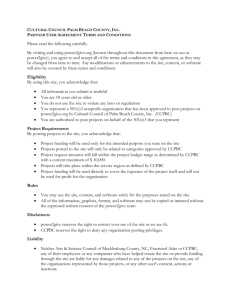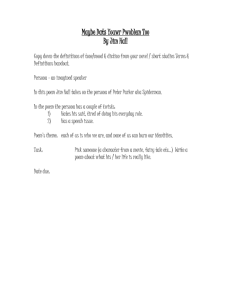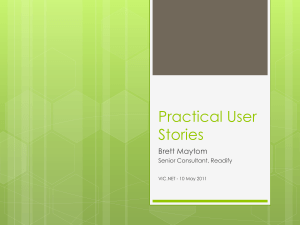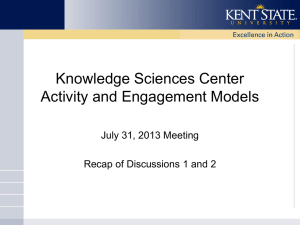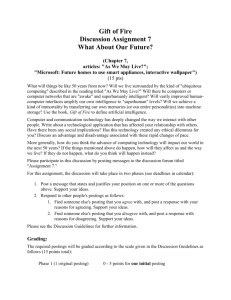"Safe Practices and Tips for Social Media" ()
advertisement
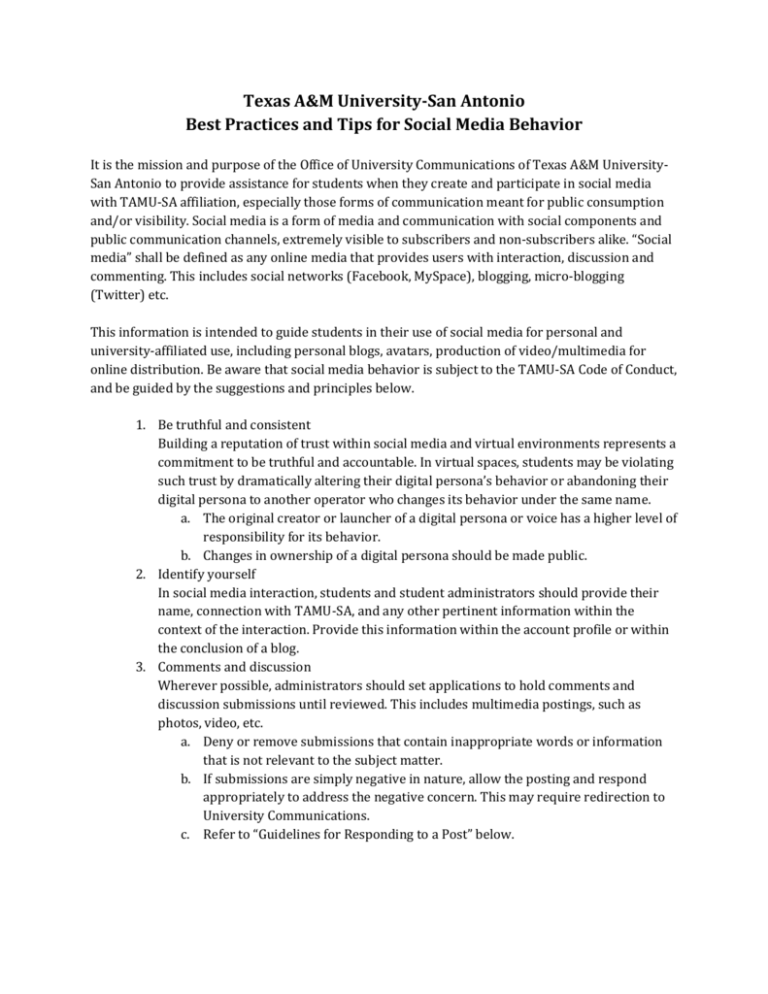
Texas A&M University-San Antonio Best Practices and Tips for Social Media Behavior It is the mission and purpose of the Office of University Communications of Texas A&M UniversitySan Antonio to provide assistance for students when they create and participate in social media with TAMU-SA affiliation, especially those forms of communication meant for public consumption and/or visibility. Social media is a form of media and communication with social components and public communication channels, extremely visible to subscribers and non-subscribers alike. “Social media” shall be defined as any online media that provides users with interaction, discussion and commenting. This includes social networks (Facebook, MySpace), blogging, micro-blogging (Twitter) etc. This information is intended to guide students in their use of social media for personal and university-affiliated use, including personal blogs, avatars, production of video/multimedia for online distribution. Be aware that social media behavior is subject to the TAMU-SA Code of Conduct, and be guided by the suggestions and principles below. 1. Be truthful and consistent Building a reputation of trust within social media and virtual environments represents a commitment to be truthful and accountable. In virtual spaces, students may be violating such trust by dramatically altering their digital persona’s behavior or abandoning their digital persona to another operator who changes its behavior under the same name. a. The original creator or launcher of a digital persona or voice has a higher level of responsibility for its behavior. b. Changes in ownership of a digital persona should be made public. 2. Identify yourself In social media interaction, students and student administrators should provide their name, connection with TAMU-SA, and any other pertinent information within the context of the interaction. Provide this information within the account profile or within the conclusion of a blog. 3. Comments and discussion Wherever possible, administrators should set applications to hold comments and discussion submissions until reviewed. This includes multimedia postings, such as photos, video, etc. a. Deny or remove submissions that contain inappropriate words or information that is not relevant to the subject matter. b. If submissions are simply negative in nature, allow the posting and respond appropriately to address the negative concern. This may require redirection to University Communications. c. Refer to “Guidelines for Responding to a Post” below. 4. Do engage A&M-San Antonio members are encouraged to explore social media responsibly to further the development of new spaces of relationship-building, learning, collaboration, and conversation. 5. Use good judgment Users will need to exercise good judgment when questionable activities or situations arise, including whether to opt-out or to proceed. Be mindful that actions, photos and messages will be visible for a long time. 6. Protect TAMU-SA’s name and your own Assume that activities in social media and virtual spaces are permanent and publicly observed. If students or student administrators conduct business or answer questions for TAMU-SA in social media or a virtual space, they are or may appear to be speaking for or on behalf of TAMU-SA. Check with University Communications if there is a question on how to proceed. 7. Protect the privacy of others Unless express consent is received, it is inappropriate to disclose or use members of TAMU-SA’s confidential or proprietary information, or any personal information of any other person or company, including real names, within social media or a virtual space. 8. Protect TAMU-SA’s and others’ intellectual property While interacting in social media or virtual spaces, avoid infringement of intellectual property rights. Always provide proper attribution of such rights. 9. Be guided by TAMU-SA values As a general rule, a student’s private life is his or her own. Students must, however, be sensitive to avoid activities in social media and virtual environments that reflect negatively on TAMU-SA. Students must follow and be guided by TAMU-SA’s values and philosophy. a. For more information on adhering to TAMU-SA values, refer to the Office of Student Engagement & Success or the Student Code of Conduct in the TAMU-SA Student Handbook. 10. Violations of Student Code of Conduct a. Inappropriate content that is in violation of the Student Code of Conduct will be referred to judicial action with the Office of Student Engagement & Success. Individuals and/or organizations may be held responsible, and will be asked to remove the content or shut down their social media account(s). Suggestions for Responding to a Post Use these steps to determine how to react: First, is the web post positive and/or balanced? If positive, factual, and well-cited, whether you agree or disagree, you may choose to not respond, or respond and share success. Follow “Response Considerations” below. If negative, evaluate to determine if the post is a troll (from a site dedicated to bashing/degrading others) or a “rager” (a rant, rage, joke or satire). If the post is a troll or a rager, avoid responding, continue to monitor, and consider removing the post. Refer to the Communications Specialist if needed. If negative with erroneous facts, respond with factual information. Retain professional demeanor and refer to University Communications if needed. If the posting is a response to a negative experience, reply to rectify the situation and pursue a reasonable response. Next, write your response with a few things in mind: Is your reply relevant and timely? Limit posts to current circumstances. If a TAMU-SA member wishes to post a story/mission, remember to disclose your TAMU-SA connection, cite sources, and consider the impression and information that will be left behind. Handy Tips for Successful Interaction: - When setting up pages and groups, fill out all information sections, keeping searchable terms in mind. Be clear and accurate in your description to make it easier for users to find your page or profile. Keep accessibility open to everyone. - Take time to create good responses. Consider the impression you will leave behind. - Assume a tone that reflects the values and heritage of TAMU-SA. - Have variety – don’t always promote yourself. Share links to community events, other student groups, or anything interesting that relates to TAMU-SA and your organization. - Be helpful to people to encourage interaction and repeat visits. Think in terms of “Don’t forget to register for classes!” or “Get a flu shot here…” Sources: TEEX Social Media 61.99.99.99-10 “Standard Administrative Procedures” 7/14/09 Air Force Web Posting Response Assessment V.2, http://upload.wikimedia.org/wikipedia/en/f/f3/Air_force_web_posting_response_assessment-v21_5_09.pdf)


